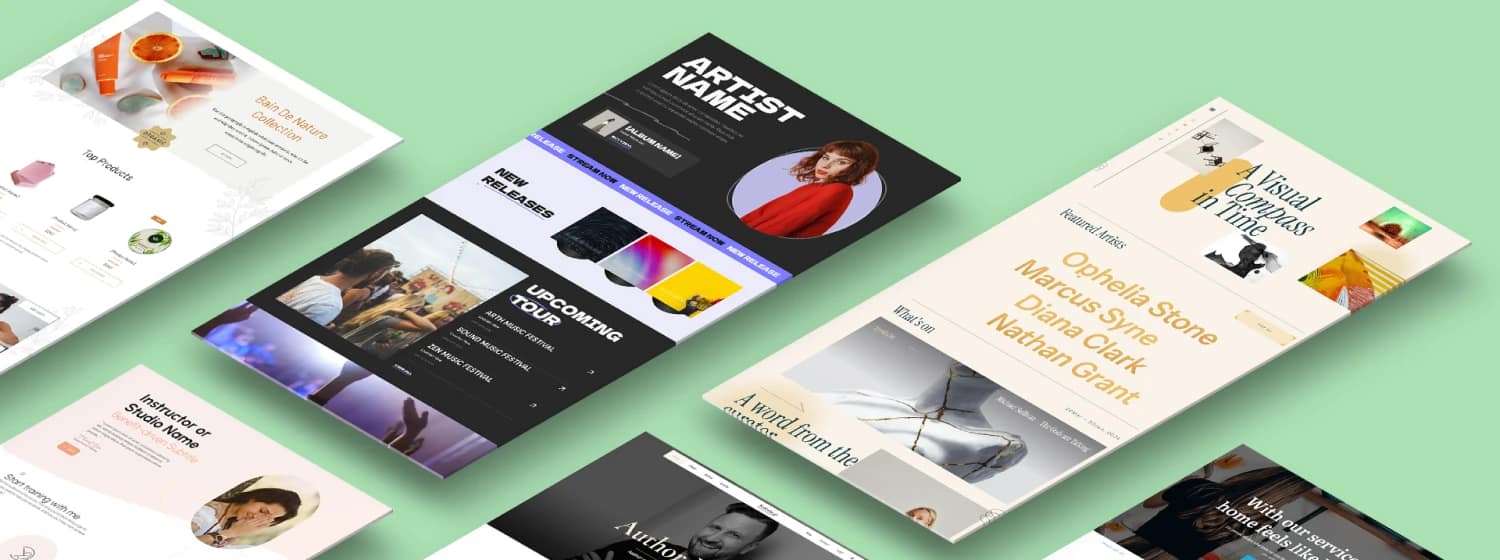There’s a special kind of irritation reserved for moments like this:
You click on something that looks genuinely helpful — a guide, a checklist, maybe a step-by-step tutorial — and before the page even loads, you get:
“Enter your name, email, blood type, and the name of your first pet to continue.”
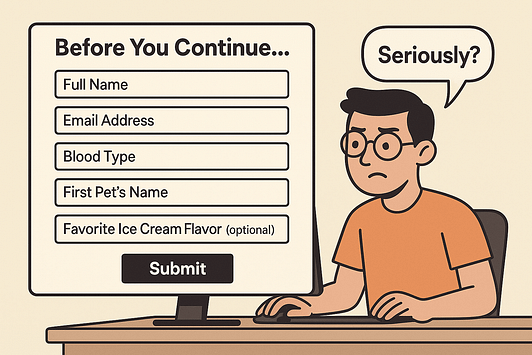
If you’ve ever asked what is gated content… well, that’s it.
Content hidden behind a form — usually part of a lead generation strategy, designed to collect email addresses in exchange for something high value.
When done well, gated content can be a super smart move – a lot of businesses have realized that.
But when it’s done poorly (and unfortunately, it often is)? It tanks trust and stalls conversions.
Research shows over 90% of people who start to sign up abandon the process — not because of the form, but because they don’t trust what happens to their email.
And we all know the result of that: a broken content marketing funnel before it ever gets going.
I’ve built a whole system to avoid bad gated offers:
I have three email addresses:
That’s still more effort than most people are willing to give.
Because gated content has a reputation problem. Not because it asks for an email, but because the content offer often falls short.
So, the key is to make sure your content is worth it.
In this guide, you’ll learn:
- What gated content actually is (and why some audiences roll their eyes at it)
- When to gate, when to give, and how to balance gated vs. ungated content without losing momentum
- How to build a high-converting content funnel using Thrive tools — no clunky plugins, no guesswork
Gated content shouldn’t feel like a trap.
It should feel like the next best step.
👇 Let’s get into it.
First — What Even Is Gated Content?
If we’re going to fix it, we need to define it.
Gated content is any piece of content hidden behind a form — usually in exchange for an email address. It’s one of the oldest lead capture tactics in the digital playbook, and for good reason: it works (when paired with a solid content conversion strategy).
You’ve seen it before:
That’s content behind a form — a friction point, sure, but also an opportunity.
In gated content marketing, the goal is to offer something so useful that the user doesn’t hesitate. They see the gate and walk through it.
No second thoughts. No decoy inbox.
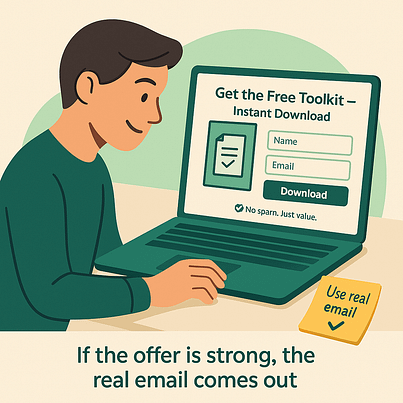
That’s only possible when the content offer feels genuinely valuable — when it solves a problem, shortcuts their process, or unlocks something they care about.
But the moment that gate feels like a trick?
You’ve lost the lead and maybe the chance to ever reach them again.
So your lesson here is:
It’s not about whether you gate — it’s what you gate, why, and how you deliver the value behind it.
Before we dive into funnel strategy, segmentation, and tech setup…
Let’s unpack why marketers love gated content — and why some audiences are (rightfully) skeptical.
Why Marketers Love Gated Content (And Why Some Audiences Don’t)
Marketers love gated content because it does what most blog posts don’t:
It turns anonymous traffic into leads you can actually talk to.
Someone gives you their email? That’s not random. That’s interest, intent, and just maybe… buying potential.
It’s no surprise then that 80% of B2B content marketing assets are gated — everyone wants a piece of that conversion pie. This is an old stat but it’s still true, and newer research backs it up:
Over 50% of marketers have made lead generation a top priority in their marketing campaigns. The numbers don’t lie.
The upside is tempting:
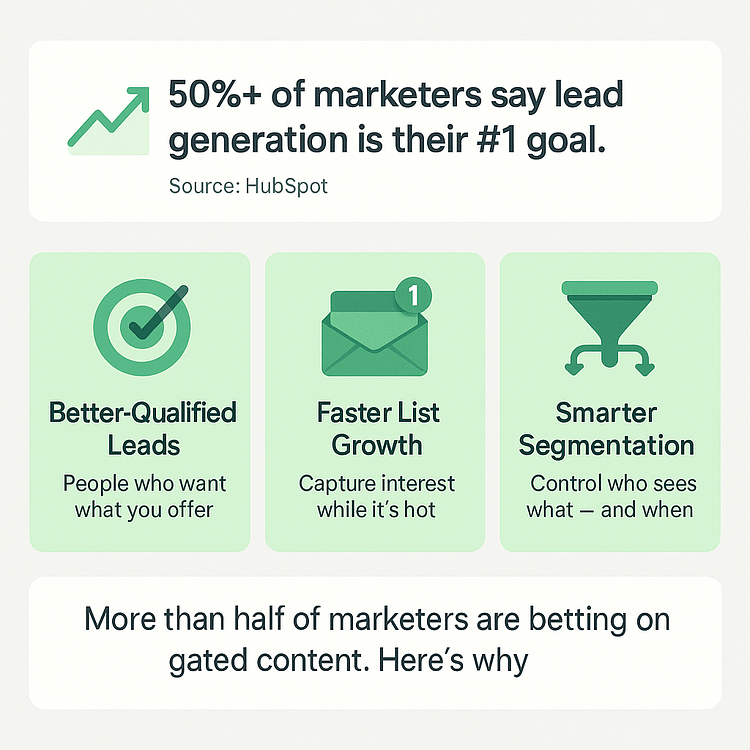
But from the reader’s side? That gate can feel less like a warm welcome and more like a pop quiz they didn’t sign up for.
Let’s call it what it is: friction.
And the risks are real:
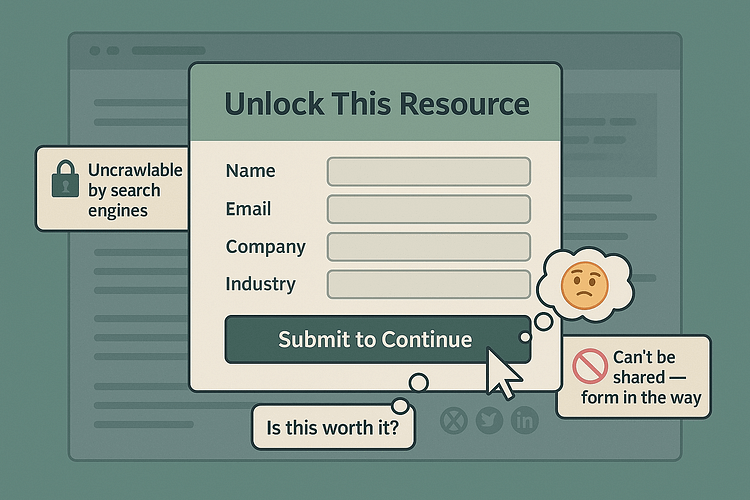
And here’s the deal-breaker:
If the value doesn’t match the ask, you don’t just lose the lead — you lose credibility.
There’s no unsubscribe link from a bad first impression.
So yes, gated content is powerful — when it respects your audience.
If your offer solves a real problem or delivers something genuinely useful, the form becomes a gateway.
If it doesn’t? It becomes a wall they won’t try climbing again.
Gated vs. Ungated Content? Don’t Choose — Build the Bridge
This isn’t an either-or situation.
Gated content marketing and ungated content should work together — not compete for space in your content strategy.
Ungated content pulls people in. It builds trust, drives organic traffic, and gives search engines something to work with — making it essential for SEO-friendly content and top of funnel content.
Think: blog posts, how-to articles, SEO guides, podcast episodes.
It’s your front door — wide open and welcoming. The start of your content marketing funnel.
Gated content, on the other hand, steps in when someone’s ready for more.
It captures attention that’s already engaged.
It filters casual browsers from serious leads and gives you the signal to start content segmentation, lead capture, and targeted follow-up.
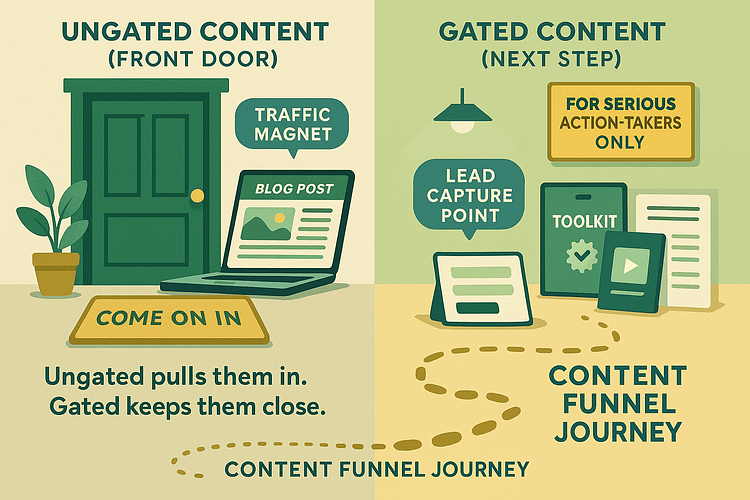
Here’s the balance:
- Ungated = Awareness, reach, authority
- Gated = Segmentation, lead generation tactics, nurture fuel
If you skip the bridge between the two? You’re just hoping people stumble into your funnel.
But when you use both together — in the right order — you build a smart, conversion-focused content system that feels smooth, not pushy.
That’s how you move someone from curious to committed — without breaking their trust (or your conversion rate).
What Content Should You Gate? (Not Everything!)
Just because you can gate something doesn’t mean you should.
Gating the wrong content — especially too early in the content marketing funnel — is one of the fastest ways to stall momentum and lose trust. If someone’s still in the awareness stage, a form can feel like a red flag, not an invitation.
📍Want to Go Deeper? Understand the Funnel Before You Gate
Before you decide what to lock behind a form, make sure you fully understand how your audience moves from awareness to decision.
Check out our full guide on the buyer’s journey — and learn how to align your gated content with real user intent.
👉 Read: The Buyer’s Journey Explained (And Why It Matters for Content Marketing)
That’s why smart marketers don’t treat gated content marketing like a blanket tactic.
They treat it like a lead magnet strategy that’s aligned with audience intent.
As your audience moves from top of funnel content to deeper stages, their goals change — and your content should change with them. What works for discovery won't work for decision-making.
The goal isn’t to hide information for the sake of it.
It’s to guide people through a thoughtful journey — one where each piece of content feels like the right next step.
Gated content works best when it’s positioned as a helpful checkpoint — not a barrier.
Used well, it becomes one of your most effective lead capture tactics for turning interest into action.
Here’s how to decide what to gate — based on funnel stage, user intent, and content that actually converts.
TOFU (Top of Funnel) – Stay Ungated
At the top of the funnel, your mission is simple: show up and provide value — no strings attached.
People at this stage are just beginning their journey. They're exploring ideas, asking basic questions, and forming early impressions of your brand. This is where ungated content earns its keep: it’s accessible, SEO-friendly, and easy to share.
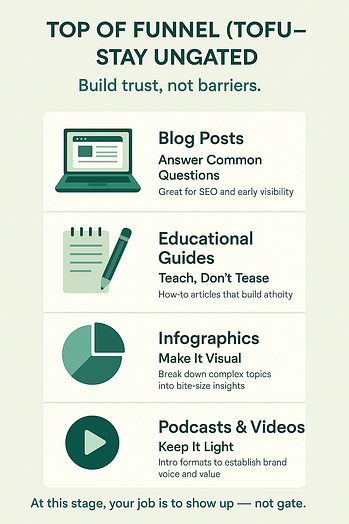
Best TOFU content formats:
Goal: Build trust and drive organic traffic.
You're not chasing conversions here — you're offering helpful content that invites them into your world.
But, gating content at this stage?
That’s like asking for a commitment before you've even introduced yourself.
MOFU (Middle of Funnel) – Gate Smart
Now we’re in the consideration phase. Your audience knows who you are and is actively exploring solutions.
This is your chance to offer mid-funnel content that’s practical, specific, and tailored to real pain points. It’s also the perfect place to introduce gated content — the kind people are actually willing to opt into.
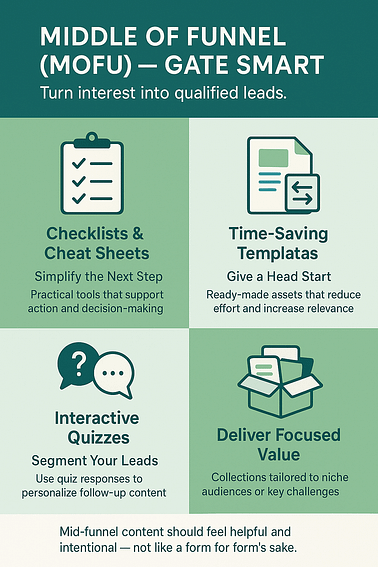
Effective MOFU gated content:
Goal: Segment, qualify, and spark deeper interest.
This is where your lead magnet strategy kicks in — offering personalized value in exchange for an email.
When done right, this step feels less like a gate and more like a logical next move in your lead generation funnel.
BOFU (Bottom of Funnel) – Gate Deep Value
Here’s where the rubber meets the road: decision stage.
Your audience is close to converting. They’re weighing options, comparing offers, and looking for reassurance. This is where your conversion-focused content needs to shine — and gating makes sense.
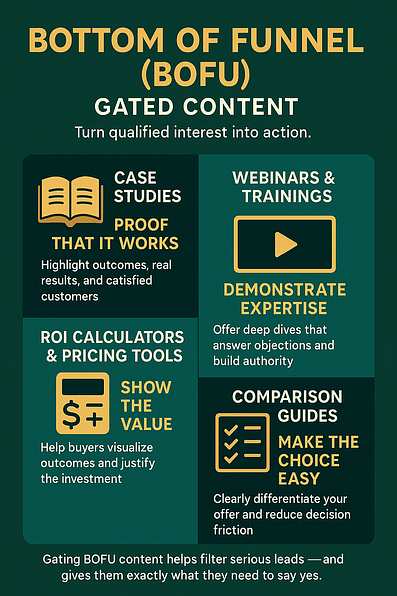
High-impact BOFU content offers:
Goal: Capture buying intent and close the loop.
These users aren’t just Browse. They’re ready to take action — and they’ll gladly trade their email for deep-value content that helps them choose with confidence.
🛠 Thrive Use Case:
Want to guide users through this journey without forcing them to guess what they need?
Use Thrive Quiz Builder to build a “Choose Your Path” funnel.
Ask a few smart questions, segment users based on their needs or level of awareness, and direct them to the right gated resource – whether that’s a quick-start template or a deep-dive case study. It’s a smarter way to earn the opt-in – and a smoother way to nurture the lead.
🧰 Quick Tools to Build Gated Content (Without the Plugin Circus)
You can build gated content with a handful of plugins, a patchwork of manual settings, and hope everything holds together... Or you can streamline the process with tools that are built to work together — and actually designed to convert. If you want your gated funnel up and running in a weekend (not a quarter), here’s what we recommend:
✅ Landing Pages: Thrive Architect
Create clean, conversion-focused pages without code. You get full design freedom — minus the wait on developers.
✅ Opt-in Forms + Smart Triggers: Thrive Leads Display the right opt-in at the right time. From pop-ups and ribbons to inline forms and screen fillers, control every trigger and placement.
✅ Smart Quizzes: Thrive Quiz Builder
Segment your audience with quizzes before they hit the gate. Show tailored results and deliver exactly what they need next.
✅ Delivery + Follow-up: Thrive integrates with your favorite email platform, so you can tag, segment, and send your lead magnet automatically — no juggling required.
👀 Want to go deeper? Explore our full breakdown of the best lead magnet tools →
🧠 How to Design Gated Content That Converts (Not Just Collects)
Now, getting someone to your email opt-in page is only half the job.
The real win? Convincing them to complete the form.
Because truthfully, most people aren’t excited to hand over their email — unless the offer is clearly worth it. If your landing page is vague, slow, or forgettable, you’ll lose them before they even finish reading the headline.
That’s where strong content conversion strategy comes in.
Every gated content offer – whether it’s a lead magnet, quiz result, or downloadable resource – should be built for momentum. From the headline to the thank-you page, you’re guiding someone through a mini-journey that ends in action.
This part of your funnel isn't just about collecting emails. It's about conversion-focused content design that feels intentional from start to finish.Let’s break down what it takes to build a gated experience that feels smooth, clear — and worth clicking for.
✅ Strong Promise = Stronger Conversion
Nobody wants to “subscribe to updates.” That’s not a compelling offer. It’s more like a shrug.
Your lead magnet should promise a specific, valuable outcome.
→ What will they learn? What problem does it solve? What shortcut are you giving them?
Instead of:
*“Download our free guide”*
Try:
*“Get the 10-step framework we used to 3x our conversion rate in 30 days”*
→ Clarity builds trust. Specificity drives action. The stronger the promise, the easier the yes.
🔓 Keep the Gate Light
You don’t need to know their shoe size.
Stick to the essentials: email (definitely), name (maybe). Anything more creates friction.
Use helpful microcopy to reduce hesitation:
✉️ “We’ll send your toolkit to this email — no spam, just what you asked for.”
→ A simple line like that shows you respect their inbox — and their time. (Need more form optimization tips? Check out this guide).
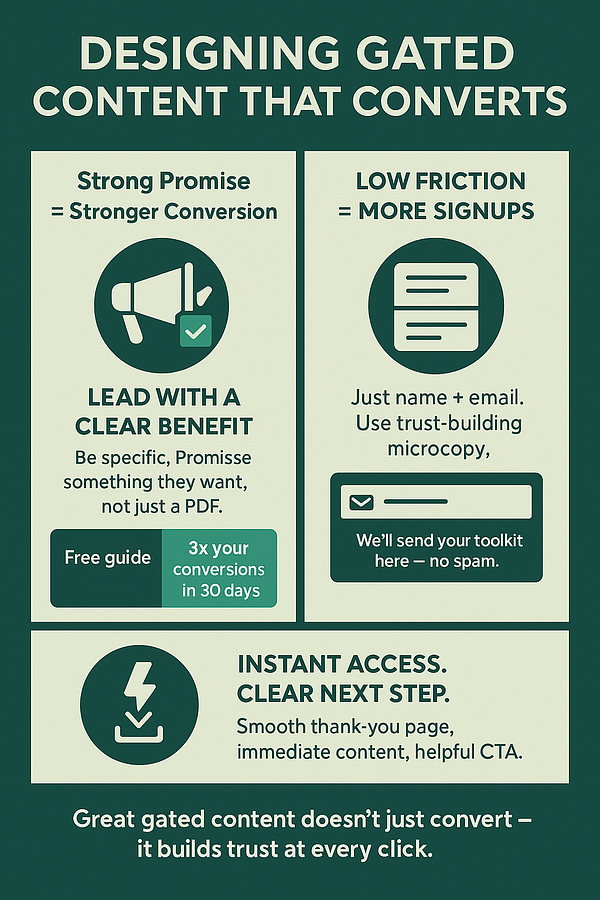
⚡ Deliver Instantly
Nothing kills momentum like a delayed delivery.
As soon as someone opts in, the experience should feel seamless:
→ Don’t just say thanks. Guide them forward with purpose.
Don’t Forget Data Privacy: It’s Personal, Not Just Legal
When someone gives you their email, they’re not just saying “sure, send the PDF.” They’re saying, “I trust you not to abuse this.”
Respect that trust with an opt-in experience that’s clear, calm, and confidence-building:
✅ Be upfront about what they’re getting and when
✅ Set honest expectations about future emails
✅ Reassure them with friendly copy like:
“We’ll send your guide right away. No spam — just useful, relevant content.”
⚙️ Want to go further? Use WPConsent
If your gated content strategy runs on WordPress, WPConsent is a simple, powerful plugin to help you:
✅ Show GDPR-compliant cookie banners
✅ Block tracking scripts until a user gives consent
✅ Log and store consent records automatically
✅ Customize permissions by region or traffic source
🧠 Bonus: It integrates with major marketing tools — so you can stay transparent and track conversions the smart way. Because protecting privacy isn’t just good practice — it’s good marketing.
🔥 Gated Content Ideas That Break the Mold (You Probably Haven’t Tried Yet)
If your gated content strategy still starts with “Download our free PDF,” it’s time for a serious upgrade.
The truth? Predictable lead magnets — generic checklists, recycled whitepapers — blend into the background. They don’t convert like they used to.
Today’s best-performing gated content is focused on engagement. It gives people a reason to care, click, and convert.
So instead of handing over another flat freebie, try building something that feels personal, useful, and genuinely exciting.
Here are four underused gated content formats that your audience will actually want to unlock.
🧰 Build-Your-Own Toolkit (Highly Clickable & Customizable)
Forget the generic PDF. Let people build the exact toolkit they need — then gate the final bundle behind a quick email opt-in.
Instead of a one-size-fits-all download, offer a menu of resources your visitors can mix and match based on their goals or challenges. Great for content segmentation and lead capture tactics that feel personalized.
What you can include:
This approach turns gated content into an interactive experience. Visitors feel in control, and you walk away with qualified leads and rich intent data.
🔧 Build it with:
Use Thrive Architect to create a landing page with visual checkboxes or toggle-style buttons for each resource. When a visitor makes their selections, direct them to a second page (your delivery page) gated by a simple Thrive Leads opt-in form. Once they enter their email, redirect them to a personalized download hub or email them the custom bundle.
🎯 Quiz-Gated Email Courses
If you want to qualify leads and deliver real value on autopilot, this is your move.
Start with a short quiz that pinpoints where someone is in their journey — or what challenge they’re trying to solve. Then, based on their answers, automatically enroll them into a personalized email course that walks them through a tailored solution.
Some high-converting ideas:
💡 This works especially well for middle-of-funnel content. The quiz acts as both a content segmentation tool and a gated offer, and the email course builds trust over time.
🔧 Build it with:
Use Thrive Quiz Builder to create a multiple-path quiz with branching logic. Assign a unique tag to each quiz outcome (e.g. Beginner, Intermediate, Advanced), then pass those tags to your email service provider (like ActiveCampaign, ConvertKit, etc.). From there, trigger an automated email course tailored to the user’s result — no manual setup needed.
🎧 Private Audio Vaults
If you’re a coach, consultant, or creator who connects best through conversation, audio content can be your secret conversion weapon.
Instead of another PDF, offer gated access to a curated audio experience — something that feels personal, exclusive, and binge-worthy.
Great options include:
Once they opt in, send them to a private landing page with a clean audio playlist or drip-access content. It’s low effort for them, high value for you — and a powerful way to build trust without needing screen time.
🔧 Build it with:
Use Thrive Architect to create your private content hub and Thrive Leads to gate it behind a short opt-in form. Bonus: Add audio blocks or embed tools like SoundCloud or Fusebox to create a seamless listening experience.
🧮 Interactive Calculators (That Gate the Results)
Sometimes the best lead magnet is one the user helps create. With interactive calculators, your audience inputs their own data — and the gated result delivers instant, personalized insight.
Why it works:
They’re already invested. They’ve answered questions or entered figures, and now they want to see what it all means. By gating the results page, you offer a relevant, conversion-focused experience that feels like a natural exchange.
Use case examples:
These calculators shine at the bottom of the funnel, where people are making final decisions. They help quantify value — and that makes them powerful content conversion tools.
🔧 Build it with:
Use Thrive Architect to design your landing page and embed a lightweight calculator (Google Sheets, ConvertCalculator, or custom HTML). Then, gate the results section using conditional content or a short form built with Thrive Leads.
📊 Measure What Matters – Or Skip the Gate Entirely
If the only metric you’re tracking is “number of downloads,” you’re not measuring success – you’re counting ghosts.
Gated content should do more than grow your email list. It should drive real movement through your marketing funnel – from first click to final conversion.
Here’s what actually matters:
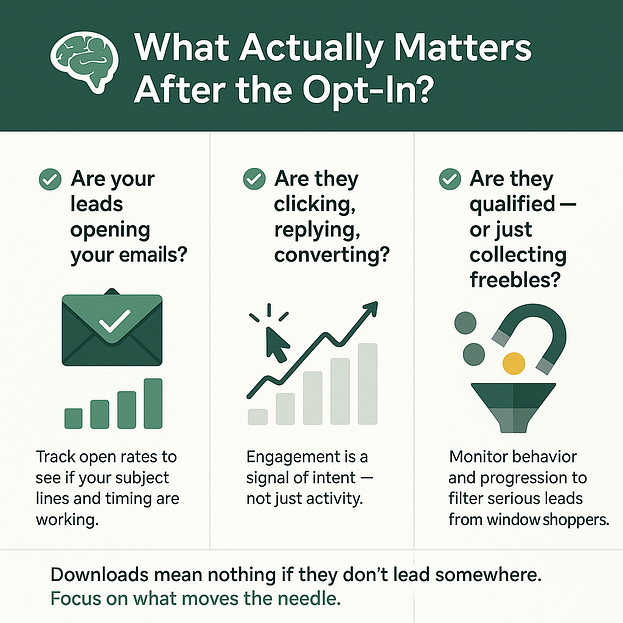
Track conversion-focused metrics like:
And don’t just track – test.
Small tweaks can unlock big improvements:
A sharper headline, a tighter opt-in form, a more specific CTA. Over time, that adds up to higher conversion rates and better leads.
❓ FAQs About Gated Content
Is gated content bad for SEO?
It can be — if you gate everything.
Search engines can’t index what’s hidden behind a form, so if your whole site is locked down, your visibility tanks.
The solution? Balance it. Use ungated content to drive traffic, build trust, and funnel visitors toward gated offers when it makes sense.
Can I use Thrive tools to gate videos or podcasts?
Absolutely.
Create a 2-step opt-in with Thrive Architect or Thrive Leads, then embed the gated video or audio on the thank-you page.
It’s a clean, conversion-friendly way to deliver exclusive content without needing a separate platform or plugin.
What if no one signs up?
That’s your signal to step back and reevaluate.
Is the offer clear? Valuable? Relevant?
Try A/B testing your headline, shortening your form, or adding preview content to increase confidence before the gate.
If people aren’t converting, the perceived value isn’t outweighing the friction.
Should I use gated content if I’m just starting out?
Yes — but go slow.
Start by building trust with ungated content (like blog posts, tutorials, or case studies).
Once you’ve earned some attention, introduce one or two high-value gated offers to start collecting leads intentionally, not desperately.
🎯 Conclusion: What Is Gated Content Really About?
If you’ve been asking *what is gated content* and whether it’s right for your marketing — the answer depends on how you use it.
So as you can see, gated content isn’t about blocking access or forcing opt-ins. Your focus should be on earning trust, guiding the right people to the next step, and showing that what’s behind the form is actually worth their attention.
At the end of the day, your audience isn’t just looking for another freebie. They’re looking for clarity, momentum, and solutions that speak to them.
So when someone enters your funnel, make it feel like a personal invitation — not a transaction.
👉 Use Thrive Architect to create a clean, high-converting funnel that doesn’t feel like a wall — it feels like a welcome.

